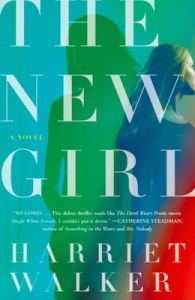As the world ground dramatically to a halt earlier this year, there came the inevitable comparisons to war, science fiction, literary dystopias—things that felt unknowable, had seemed impossible, only a few weeks earlier. From my home in locked-down London, I shared the disbelief, the sense of the surreal, the oh-my-God-can-this-really-be-happening-ness of it all as though I was watching a disaster movie play out on TV.
But I also felt a rush of recognition—a tingle of humdrum familiarity, as at a party when you meet the eye of somebody you knew a long time ago and don’t particularly want to speak to. Oh, it’s you again, I thought, I remember you.
As the world shut down, any woman who has been on maternity leave with a newborn will have felt the memory of confinement shiver through them like a déjà vu: the smothering closeness, after a while, of one’s own home and company. And any reader or writer of thrillers knows the power of isolation too: there is nothing quite like too much time by yourself to set in motion the wheels of doubt, intrigue and potential destruction.
I started writing my novel The New Girl while on leave with my first child. Having almost 10 months at home, away from my job as fashion editor at The Times, was the first time I had been able to listen to my own thoughts in years—even though there was often a tiny person screaming over the top of them.
Without the daily deadlines and Twitter-length attention span that are a key part of being a twenty-first century journalist, I felt my concentration unspool from staccato sentences into long-winded baggy prose. I thought in plot arcs rather than headlines, and I spent my days walking with the buggy in the woods and the parks near my house. As the rhythm of the wheels lulled my daughter to sleep, I followed potential storylines and character developments to their conclusions. Unlike at work, my brain didn’t try to multi-task or open another tab as I did so.
But where I started writing as a consequence of being alone with my own thoughts, for my protagonist Margot—herself at home with a baby—the reflexive removal from the world that comes with early motherhood is a catalyst for dread and anxiety, the means of dredging from within her the guilty secret she has been carrying for so long.
The creak on the landing, a door banging when there is no breeze, the light still on you’re sure you switched off—when we are the sole agent in a space for a protracted time, our imaginations go into overdrive. The most successful thrillers of recent years are proof that you don’t have to be holed up in a cabin in the woods or abandoned at a snowy hotel to experience similar skin-pricklings of dissociation—perhaps your spouse is away for the night, or your flatmates didn’t tell you they’d be back late.
As our homes have emptied of other people, we are in fact more watched, more scrutinized and more judged inside them than ever.Just as in AJ Finn’s The Woman in the Window, a home you love can reverberate with emptiness after a while, while loneliness can be the stuff of horror in its own right. Watching others interact easily when you don’t feel capable of it is a fear that afflicts many of us in the first five minutes of arriving anywhere. Meanwhile, as in Alex Michaelides’s The Silent Patient, long shut-away trauma doesn’t always remain politely behind closed doors.
Thriller writers know that the subconscious can be a character’s own worst enemy, easily roused to paranoia and just as likely to reveal its murkiest depths by sheer, thoughtless accident as by design. As our lives become more virtual than physical, modern suspense and noir have shifted focus from the laying of actual clues to digital means of signposting events and information that don’t even require characters to leave the house.
In The Lost Night, Andrea Bartz has the lonely Lindsay trawl through vintage profile pictures and obsolete tech to piece together the memories she is missing, while in Magpie Lane, Lucy Atkins’ intriguingly anti-social narrator Dee uses her antipathy towards modern gadgetry as yet another layer with which to protect her privacy. In choosing to be offline in a connected world, she is part-ghost herself within the book’s gothic-inflected moral quandary. Both authors are concerned with the obsessive tendencies of the mind when it is hived off from authentic and immediate social interaction.
In The New Girl, I wanted to look at how work and home life shape the modern female identity, and how each serves as a grounding element in one’s self-perception, an anchor on reality and who we think we are. Margot is a successful career woman who finds herself newly domesticated, but her transition to stay-at-home mum is not wholesome and fulfilling, as she expected. Instead, motherhood makes her superstitious and fearful—that Maggie, the younger, temporary replacement in the office she has vacated, is undermining her, and that her best friend Winnie is judging her abilities as a mother.
As Margot further withdraws from the world, an anonymous internet troll begins to voice some of her darkest fears. We no longer share our homes with an unsettling Mrs Danvers figure who whispers poison behind the drapes to the solitary Mrs De Winter in Daphne du Maurier’s Rebecca, but the toxic voices are still with us through the apps we store on our phones. As our homes have emptied of other people, we are in fact more watched, more scrutinized and more judged inside them than ever.
Ours is the first generation to be able to experience isolation in such close proximity to the life that is carrying on without us. On maternity leave, Margot is able to spectate on both Maggie and Winnie via social media without interacting with either of them. The vulnerabilities that come with female rivalry and friendship clatter deafeningly against the sheet of soundproof glass that lies between Margot in her home and the other women out in the world. As her paranoia begins to wear her husband down, Margot finds herself increasingly alone in her marriage too.
When my daughter was tiny and we spent whole days with only each other rotating between kitchen, sitting room and bedroom, I saw peril in every household object, watched in my mind’s eye as I smothered her, dropped her, drowned her.
“It’s your mind’s way of keeping your baby safe,” a desperate visit to a parenting site told me during one 4am feed and Google session. “You’re evaluating the dangers.”
In The New Girl, I made them Margot’s reason for staying indoors.
The hermit’s home can be both refuge and tomb; in a thriller, the familiar is as like to turn on you as not.But the hermit’s home can be both refuge and tomb; in a thriller, the familiar is as like to turn on you as not. In one of the earliest examples of domestic noir, The Dead Secret by Wilkie Collins (published in 1856), the key to the mystery of identity at its heart lies ready to be disturbed in a forgotten room and the tricksy psychology of its heroine becomes inextricably linked to the house itself. As Victorian society began to debate women’s rights, its male novelists made them the creaky underpinnings of the happy home: too much liberation would bring everything down around the family’s ears. These days, Louise Candlish creates female characters who unwittingly isolate themselves by forging uneasy alliances beyond the safety their homes offer.
Homes can turn on their inhabitants too, stuffed as they are with items that might prove the key to somebody’s undoing—in Liane Moriarty’s The Husband’s Secret, the discovery of a handwritten note in the attic prompts the unravelling of a decades-old lie. The bricked-up woman, whether trapped literally or metaphorically, has been a leitmotif for domestic turmoil and marital anxiety since Bertha Mason lit her first fire in Jane Eyre. Where hunters work by separating their target from the rest of the herd, writers pen their prey in the comfort of their own surroundings—see Look to Your Wife by Paula Byrne—or in the lifestyle choices they have made. Chandler Baker’s corporate-feminist thriller Whisper Network features not so much a glass ceiling as a glass box: the pumping room allocated to breastfeeding mothers at a top legal firm.
My novel The New Girl is about the trauma and paranoia of one’s sense of self shifting into an unfamiliar phase, as happens so dramatically after the birth of a child. If identity is about balancing external and internal pressures to keep’s one outline in tact, then prolonged time alone can tip those insides onto the outside, where others might poke around in them.
Isolation thrillers are as much about unearthing things as detective fiction is: memories, motivations and meaning lead the characters if not to justice then to a greater understanding of themselves and their role in what has played out. That understanding then works to break the confinement and reunite the protagonist with the world beyond their own head—as with Gail Honeyman’s tale of the unseen, urban friendless in Eleanor Oliphant is Completely Fine.
Given we are all—for now at least—stuck in our own homes, perhaps it is not the filmic shots of empty cities and deserted streets that should be giving us the creeps, but instead the suggestive power of our own mind and the prospect of too much time alone in its company.
***


















